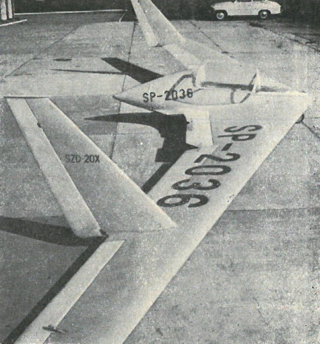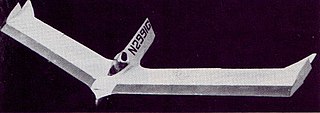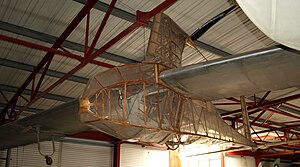
The Scheibe Spatz is a German glider with a mixed metal and wood construction that was built in 1952 until 1962. Later versions were known as the L-Spatz, the letter L standing for Leistung, which is German for "performance".

The Lo-100 is an aerobatic glider of classic wood and fabric construction well suited to amateur building methods. The designation Lo was bestowed by the designer Alfred Vogt in memory of his brother Lothar Vogt, with whom he had developed the predecessor model Lo-105 Zwergreiher. The first flight of the prototype took place in 1952 at the Klippeneck. An example is on display at the Gliding Heritage Centre.

The Aer-Pegaso M-100 was a single-seat glider designed and built in Italy from 1957.

The Antonov A-13 was a Soviet aerobatic sailplane flown in the 1950s and 1960s. It was a small, single-seat, all-metal aircraft developed from the A-11 which could optionally be fitted with that aircraft's longer-span wings. It was a mid-wing monoplane with a tadpole-like fuselage and a V-tail.
The Schneider ES-59 Arrow is a sailplane designed and manufactured in Adelaide, South Australia in the early 1960s. The Arrow was manufactured with a one-piece wing of 13.23 metres span. It was the first Australian-built sailplane to compete in the World Gliding Championships, 1963 in Argentina. The Arrow has wood/fabric wings and tail and a wood fuselage. It has a fixed main wheel and a nose skid.
The PIK-3 was a sailplane produced in Finland in the 1950s and 60s. It was designed to be a cheap and easy-to-build aircraft to equip the country's gliding clubs as their standard single-seat machine. It was a conventional design for its day, with a high wing and conventional empennage. Construction was of wood throughout, skinned in plywood.

The PIK-5 was a training glider produced in Finland in the 1940s, and 1950s, equipping the country's gliding clubs with an aircraft greater in performance than primary gliders but less than competition sailplanes.

The SZD-17X Jaskółka L was a single-seat high-performance competition glider designed and built in Poland at Szybowcowy Zakład Doświadczalny in Bielsko-Biała in 1955.

The SZD-20x Wampir II was a single-seat tail-less research glider designed and built in Poland from 1959.

The IS-4 Jastrząb was a single-seat aerobatic glider designed and built in Poland from 1949.

The IS-5 Kaczka was a single-seat canard research glider designed and built in Poland from 1948.

The Slingsby Type 45 Swallow was designed as a club sailplane of reasonable performance and price. One of the most successful of Slingsby's gliders in sales terms, over 100 had been built when production was ended by a 1968 factory fire.
The Schneider ES-52 Kookaburra is an Australian two-seat training sailplane of the 1950s and 1960s. It was designed by Edmund Schneider, the designer of the Grunau Baby, who had emigrated to Adelaide, South Australia following the end of the Second World War.
The Civil Aviation Department RG-1 Rohini is an Indian two-seat training sailplane of the 1960s. A high-winged wooden monoplane, with side-by-side seating;at least 107 were built.

The Lehtovaara PIK-16 Vasama is a Finnish mid-wing, single-seat, FAI Standard Class glider that was designed by Tuomo Tervo, Jorma Jalkanen and Kurt Hedstrom, who were students at the Polyteknikkojen Ilmailukerho (PIK) and produced by Lehtovaara.

The Brochocki BKB-1 was a Canadian mid-wing, single-seat, experimental tailless glider that was designed and constructed by Stefan Brochocki with assistance from Witold Kasper and A. Bodek. The designation indicated the contributions of all three men. The aircraft was intended to study flight above the stall angle.

The Antonov A-15 is a Soviet mid-wing, V-tailed single-seat, FAI Open Class glider that was designed by Oleg Antonov and produced by Antonov.

The Wassmer WA-30 Bijave is a French two-seat advanced training glider designed and built by Wassmer Aviation of Issoire.

The Antonov A-11 is a single-seat, high performance, all-metal sailplane built in the Soviet Union in the late 1950s. 150 were produced.
The IS-4 was a high performance glider designed by Iosif Şilimon and built in Romania in the late 1950s at the URMV-3 factory at Braşov.















